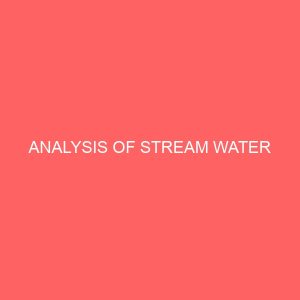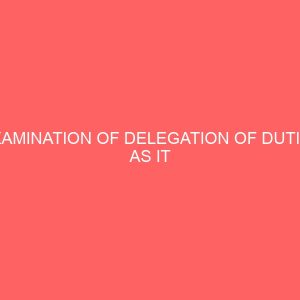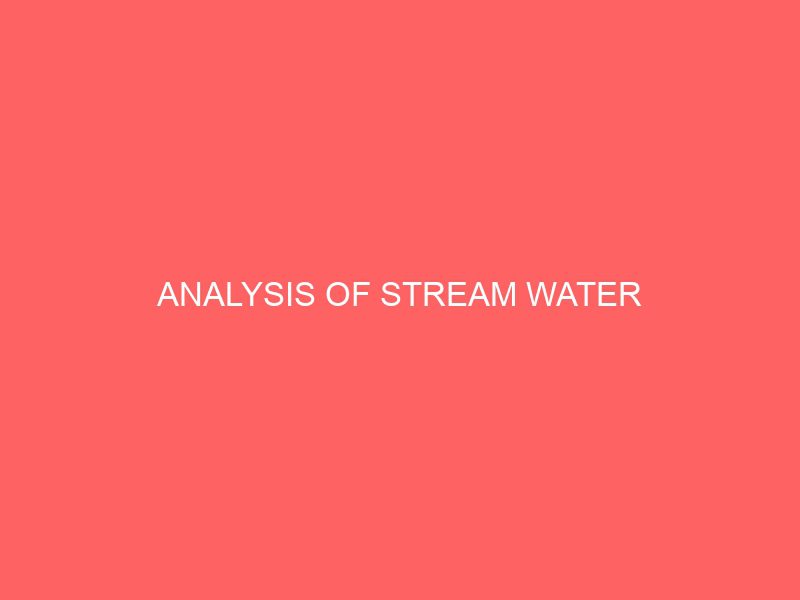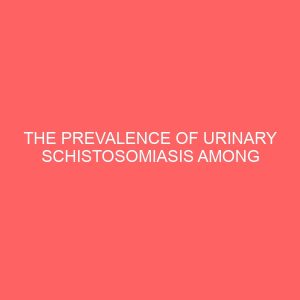Description
ABSTRACT
The bacteriological quality of five 5 streams in Enugu urban metropolis was assessed. The membrane filtration method was used to estimate the total coliform and Heterotrophic bacterial count of the stream waters. The coliform count of the stream ranged between 6 and 10 cfu/100ml; while the total heterotrophic bacterial count ranged between 34 and 59 cfu/100ml. Escherichia coli was isolated from three 3 streams out of the five 5 samples analyzed. The bacterial isolated from the samples include Escherichia coli, Bacillus sp., Staphylococcus aureus, Klebsiella sp., Proteus sp., Erwinia sp. and Serriatia sp. The research work has indicated that streams in Enugu urban metropolis were found to be unfit for human consumption since none of the water samples, satisfied the Nigeria Industrial Standard NIS for drinking water quality and the coliform count were not within the recommended limits for portable water as given by World Health Organization WHO.
TABLE OF CONTENT
Title page i
Certification ii
Dedication iii
Acknowledgment iv
Abstract vi
Table of Contents vii
List of Tables viii
List of figures ix
CHAPTER ONE
Introduction 1
CHAPTER TWO
2.0 Literature Review 6
2.1 Sources of Drinking Water 10
2.2 Contamination of Water 18
2.3 Indicator of Faecal contamination 19
2.4 Microbiological Method 21
2.5 Prevention of faecal waste 24
2.6 Water treatment / purification 25
CHAPTER THREE
3.0 Materials and Method 29
3.1 Study area and sampling 29
3.2 Collecting of sample 30
3.3 Sterilization of material and aseptic technique 32
3.4 Membrane filter technique 32
3.5 Identification of Isolates 33
3.6 Estimation of total Bacteria count 33
3.6 Presumptive Coliform counts 34
3.7 Faecal coliform counts 34
3.8 Pure culture isolation 35
3.9 Bacterial Identification of isolate 35
3.10 Biochemical Test 37
CHAPTER FOUR
Result 46
CHAPTER FIVE
5.0 Discussion, Conclusion and Recommendation 52
5.1 Discussion 52
5.2 Conclusion and Recommendation 54
Reference 56
Appendix I 63
Appendix II 64
LISTS OF TABLES
Table Description Page
1 Some pathogenic microorganisms found in stream water 32 2 Sources and number of water sample collected
31 3 Heterotrophic bacterial and coliform count of the water samples 47 4 Bacterial isolated from each of the water source 5 Summary of the bacteriological quality of the five 5 streams 6 Physiochemical properties of the bacteria isolated
LIST OF FIGURES
Figures Descriptions Page 1 Histogram representing the percentage of total coliform bacterial contamination of streams in Enugu urban metropolis
CHAPTER ONE
1.0 INTRODUCTION
Water is a basic necessity of life and many diseases can easily be transmitted through it. It is a chemical substance that is composed of hydrogen and oxygen and is vital for all life Hayakawa et aI, 2000.
Water is the most abundant commodity in nature, yet, it is one of the scarce commodities for man. It occupies about 70 of the earths surface Orji et al, 2006. In typical usage, water refers only to its liquid form or state, but the substance also has a solid state, ice, a gaseous state, water vapour or steam Hayakawa et al, 2005. Water on earth moves continually through a cycle of evaporation or transpiration evapotranspiration, precipitation and runoff, usually reaching the sea. Evaporation and transpiration contribute to the precipitation over land Hayakawa et al, 2005.
Natural water are grouped into three 3 major groups and they are; Atmospheric water, Surface water and underground water. The availability of each source depends on the geographical location. Rain water is pure as it falls but may pick up impurities from the atmosphere.








Reviews
There are no reviews yet.